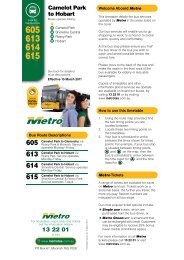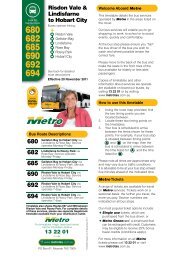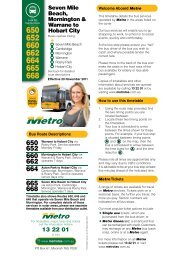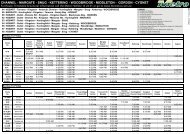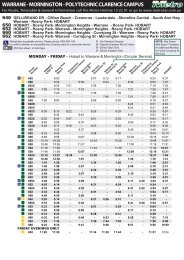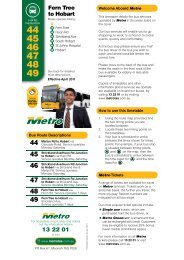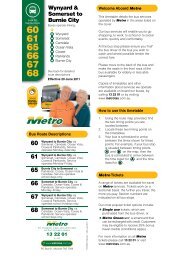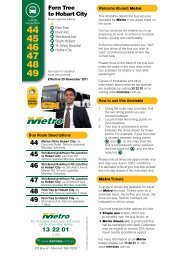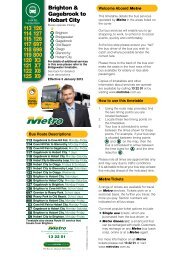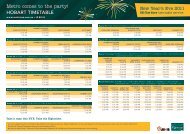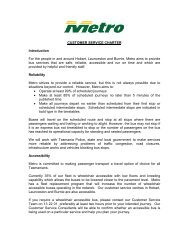Annual Report for 2006/07 - Metro Tasmania
Annual Report for 2006/07 - Metro Tasmania
Annual Report for 2006/07 - Metro Tasmania
- No tags were found...
Create successful ePaper yourself
Turn your PDF publications into a flip-book with our unique Google optimized e-Paper software.
Chief Executive Officer’s ReviewAs I noted in last year’s <strong>Annual</strong> <strong>Report</strong>, increased patronage is thefundamental basis to underpin <strong>Metro</strong>’s future.Delivery of quality customer service and the provision of services thatare relevant to the needs of the community continue to be vital <strong>for</strong> ourorganisation.It is there<strong>for</strong>e very pleasing to report that in <strong>2006</strong>/<strong>07</strong> <strong>Metro</strong> carried9,945,000 people, just 55,000 short of the magic 10 million mark,and 340,000 more than during the previous financial year. It is alsoimportant to note that this is <strong>Metro</strong>’s best result since 1997/98.In percentage terms patronage increased by 0.5 per cent statewide,with adult patronage increasing by 0.6 per cent, adult concessionpatronage by 0.7 per cent and student patronage by 0.3 per cent.Looking ahead to the next financial year, patronage growth is expectedto continue at about the same rate.In January 20<strong>07</strong> <strong>Metro</strong> reluctantly increased the prices of some ticketsto cover cost increases since the last fare increase in January <strong>2006</strong>.Fares <strong>for</strong> Adult Concession, Child and Primary/Secondary Studentswere held at <strong>2006</strong> levels. Together, these groups comprise almost 75per cent of <strong>Metro</strong>’s business.Adult full fares were restructured as part of a long-term move toa simpler fare structure, as proposed by the Government PricesOversight Commission.Occupational Health and Safety continued to be a priority <strong>for</strong> <strong>Metro</strong> in<strong>2006</strong>/<strong>07</strong>.The Lost Time Injury Frequency Rate (lost time claims greater than oneshift multiplied by one million and divided by total number of hoursworked) was halved from 66 in 2005/06 to 33 this year.The annual severity rate of injuries (number of days lost multipliedby one million and divided by the total number of hours worked)dramatically fell from 696 last year to 150 in <strong>2006</strong>/<strong>07</strong>.Workers compensation claims this financial year also reducedfollowing the introduction of a new approach to injury management.<strong>Metro</strong> operates 215 buses in Hobart, Launceston and Burnie, of which42 are wheelchair accessible.In <strong>2006</strong>/<strong>07</strong> <strong>Metro</strong> commenced a contract <strong>for</strong> the supply of 20 DisabilityDiscrimination Act (DDA) compliant buses. Delivery of the first units isscheduled <strong>for</strong> early 2008 with 8 new buses expected to be deliveredand operating in service by June 2008. The remaining 12 buses are tobe supplied in the following financial year. The contract also allowsthe option <strong>for</strong> a further 20 buses to be built <strong>for</strong> <strong>Metro</strong>.The vehicles feature air conditioning, low emission Euro 4 & 5 dieselengines, Scania chassis, and bodies supplied by South Australianbasedcompany Custom Coaches Pty Ltd.In addition, there will be two further accessible buses delivered in20<strong>07</strong>/08 from historical orders, including <strong>Metro</strong>’s first long-wheelbase 14.5 metre bus with steerable rear tag axle to increase vehiclemaneuverability. If trials of this vehicle are successful it is likely thatfurther buses of this type will be used as replacements <strong>for</strong> <strong>Metro</strong>’sarticulated buses.In <strong>2006</strong>/<strong>07</strong> <strong>Metro</strong> became the first bus company in Australia to beaccredited to undertake its own vehicle inspections under the NationalHeavy Vehicle Accreditation Scheme.Programmed maintenance of vehicles is undertaken every 15,000kilometres but the intention is to extend that to 20,000 kilometres inthe short-term to improve bus availability and free up resources tofocus on predictive maintenance.During the year <strong>Metro</strong> announced that it was planning to introduce asingle new ticketing system to cover all of <strong>Metro</strong>’s operations.<strong>Metro</strong> currently operates three ticketing systems – one coveringHobart and Launceston, one in Burnie and one on Hobart Coaches.The proposed replacement system is a smartcard-based ticketingsystem, widely regarded as the most versatile and best availabletechnology.<strong>Metro</strong> has undertaken extensive research to ensure any new systemwill be reliable, flexible and user-friendly and has taken accountof comments from various stakeholders, including employees,passengers, suppliers, other operators and government, to developappropriate specification and tender documents.While the current ticketing systems are still operating well, in the caseof the Hobart and Launceston system, it is 20 years old and due <strong>for</strong>replacement.<strong>Metro</strong> introduced a number of changes to its Hobart timetables androutes in November <strong>2006</strong> following a comprehensive review of allservices and consultation with bus operators.The changes were designed to ensure <strong>Metro</strong> services continue to runon time following increases in traffic congestion.The new simplified routes on regular timetables through West Hobart,Mt Stuart and Lenah Valley not only achieved its goal but resulted inincreases in patronage on evening services and at weekends.At the same time, a simplified Busy Bee route was introduced toSandy Bay during evenings and weekends. The route was redesignedto ensure better access to the University Campus and Sandy Bayshops during off peak times.Last year I wrote that <strong>Metro</strong> was working to establish closer workingrelationships with local government that would ultimately develop abetter understanding of the needs of the communities in which <strong>Metro</strong>operates.In <strong>2006</strong>/<strong>07</strong> the Clarence City Council and <strong>Metro</strong> signed amemorandum of understanding (MOU) – the first of its kind in theState – to implement the joint Accessible Clarence Program.The program aims to provide the Clarence community with the bestpossible public transport services and facilities in a cost-effectivemanner.Following the signing of the memorandum with Clarence, <strong>Metro</strong>also signed an MOU with the Launceston City Council and discussedsimilar arrangements with the Brighton Council and the Burnie CityCouncil.<strong>Metro</strong> is continuing to work with local government organisationsstatewide to further enhance the effectiveness of its public transportservices to the community.<strong>Metro</strong> believes local government is the perfect partner to achievepositive outcomes given its strong relationship with the community itrepresents.Chief Executive Officer’s Review



